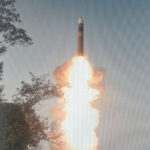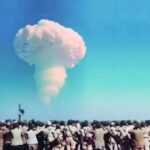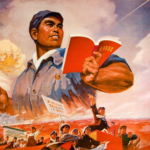Hiroshima, (re)visited
By Laura H. Kahn | August 3, 2009
After the Japanese attacked Pearl Harbor on December 7, 1941, my father, who had struggled through the Great Depression to become a surgeon, volunteered with the U.S. Army. He was stationed in the United States for some time, but eventually sought an overseas assignment. In March 1944 he shipped out of San Francisco to join the 35th General Hospital in New Guinea and then, one year later, transferred to the 1st Portable Surgical Hospital at Leyte Island in the Philippines where he operated on wounded soldiers in an active combat zone. Soon after he arrived in the Philippines, his commanding officers gathered the troops together and informed them that the United States soon would be invading Japan and that this action would result in tremendous casualties.
As we left the Peace Memorial Museum in Hiroshima, my 8-year-old son, who is fascinated by all things military, stated matter-of-factly that there should be no more wars.”
But an invasion would prove to be unnecessary. On August 6 and August 9, 1945, the United States dropped atomic bombs on Hiroshima and Nagasaki. Days later, World War II ended with Japan’s surrender. In the Philippines, my father and his fellow soldiers were notified that they would be some of the first troops to occupy Japan. Shortly thereafter, he and his colleagues landed in the island nation. Visiting Hiroshima, he saw a city reduced to rubble, globs of melted glass scattered about, and shadows on the ground where people once stood. He spent a few months in Japan before being discharged back to the United States. Almost 65 years later, at a frail 92 years of age, my father insists that the atomic bombings of Hiroshima and Nagasaki saved his life and the lives of his fellow soldiers.
My children and I traveled to Japan this summer to join my husband who had left a few weeks earlier to work with Japanese colleagues. Since I had never been to Japan before, I insisted that we visit Hiroshima. My father’s recollections haunted me, and I wanted to see the city. While riding the Shinkansen bullet train from Tokyo to Hiroshima, I took the opportunity to reread John Hersey’s book Hiroshima, in which he chronicled the experiences of six people who survived the bombing. I felt conflicted. As I read the horrors of what Hiroshima residents went through, I couldn’t help but also think about what might have happened to my father if the bombings hadn’t occurred.
My family arrived in Hiroshima and went straight to the Peace Memorial Museum, which is located near ground zero. Exhibits in the East Building describe Hiroshima’s history and Japanese war activities before the bombing. We read about Japanese military engagement in China from 1931, the Nanking massacre in 1937, and the surprise attack on Pearl Harbor in 1941. Exhibits in the Main Building described the effects of the bombings and the profound suffering of the victims. It was the most moving part of the museum.
At one point, my 12-year-old daughter asked about keloids, unsightly thickened scars that commonly result from severe burns and which are one of the many damaging effects of radiation exposure. She was scared that something like this might happen to her. After I explained what keloids were, she left the exhibit. She had had enough. I could understand her response. I found it depressing to have to explain the medical horrors of nuclear explosions and radiation effects to my children.
We found the videotaped testimonies of the survivors the most powerful exhibit in the museum. For example, Akihiro Takahashi was a 14-year-old attending a junior high school 1,500 meters from ground zero. He was blown off his feet when the bomb exploded and suffered severe burns over much of his body. While walking home, which was 6 kilometers away, he ran into a friend who also was badly burned. He tried to help his friend despite his own injuries.
As we left the museum, my 8-year-old son, who is fascinated by all things military, stated matter-of-factly that there should be no more wars. My 15-year-old son exclaimed, “Can’t people just talk things out with diplomacy?” My daughter bought a “Hiroshima Peace” T-shirt that she could wear to school and educate her friends. I could not help but be proud of all three of them.
Did the atomic bombs end the war in the Pacific? It’s debatable. (In fact, a 2005 Bulletin roundtable examined that exact question.) A colleague recommended that I read the book, Racing the Enemy: Stalin, Truman, and the Surrender of Japan by Tsuyoshi Hasegawa, a professor of history at the University of California-Santa Barbara, for a different perspective than what I was accustomed to hearing. Hasegawa conducted an in-depth analysis of the end of the Pacific War by examining the roles of the United States, the Soviet Union, and Japan and concluded that it wasn’t the atomic bombings that ended the war, but rather Stalin’s declaration of war against Japan on August 9 when Japan refused to accept the terms of unconditional surrender from the United States, Britain, and China. The Soviet declaration of war and subsequent invasion into Manchuria was, according to Hasegawa, a greater shock to the Japanese leaders than the atomic bombings. They saw no alternative but to accept unconditional surrender. Having grown up hearing the U.S. side of the story, I found this alternative viewpoint unexpected but certainly plausible. Clearly, there is no simple explanation for how the war ended.
Unfortunately, the United States opened a Pandora’s box in using atomic bombs. We now have a full picture of the horrors these weapons bring–not just the immediate effects of instantly killing untold numbers of people but also the lifelong suffering of the victims and their unborn children. Such weapons are a crime against humanity, and their use should be universally condemned.
I returned to Hiroshima 64 years after my father had visited the city. Yet, even being surrounded by the past, I couldn’t help but think of the future. If my children return to Hiroshima in another 64 years, how will they find the world? Will we have taken steps toward a nuclear-weapon-free existence, or will our inability to stop proliferation lead to future Hiroshimas?
Together, we make the world safer.
The Bulletin elevates expert voices above the noise. But as an independent nonprofit organization, our operations depend on the support of readers like you. Help us continue to deliver quality journalism that holds leaders accountable. Your support of our work at any level is important. In return, we promise our coverage will be understandable, influential, vigilant, solution-oriented, and fair-minded. Together we can make a difference.
Topics: Columnists, Nuclear Weapons















